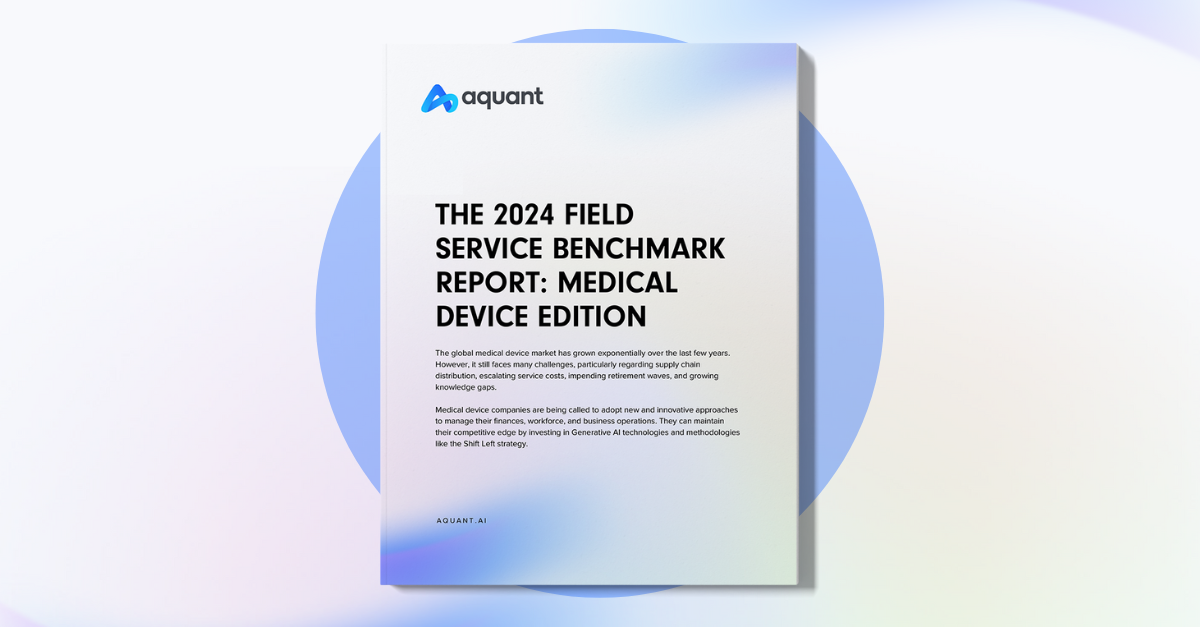We’re thankful for all of the clients, partners, analysts, and other industry leaders who have shared their knowledge over the past year. Together, these pros have decades of service industry experience that could fill dozens of articles. But we know you have a service organization to lead, so we did the legwork for you and distilled their insights into seven actionable tips.
A few themes kept emerging: empowering your people, investing in the right technology, and making the most out of service data. Read on for our favorite pieces of wisdom.
Plan for the Unexpected
Being prepared is never a bad idea and will always pay off.
IDC’s Aly Pinder Jr. said it best: “What is most intriguing throughout this crisis is organizations that had digital transformative initiatives in place were quicker to return to growth [compared to] those that had limited capabilities around technology.”
In the midst of a global pandemic or in the midst of business as usual, setting up your organization for digital transformation always pays off. It also avoids unnecessary scrambling when priorities change a little (or a lot).
Read more: 4 Predictions for Service Organizations in and Out of the Field in 2021.
You Can Always Think More Strategically About Tech
Speaking of growth, we’re ready to leave behind the notion that investing in tech is only about productivity improvements. There’s so much more to it than that. It’s about empowering your teams to make the biggest impact possible for your customers.
When you invest in a new technology, ask yourself: Can it help us solve customer challenges in a smarter way (like remote service)? Can it enable us to innovate in a way we couldn’t before? Can it free up some of our biggest roadblocks and help us focus on what’s really needed to transform our business?

“It’s all about how technology can help us deliver on the service promises and maintenance promises we have for our customers.”
— Aly Pinder Jr., IDC
Read more: 3 Biggest Challenges for Service Organizations in 2021.
Your Employees are Your Most Valuable Asset
In other words, even the best technology can only take you so far. To get the rest of the way, you need talented employees behind that tech. That’s why attracting and retaining talent is so important. And if you have a lot of Gen Z and Millennial employees, Rodger Smelcer of United Service Tech has plenty of advice for you. For starters, Rodger has one of the youngest service teams in the industry, and he’s found ways to manage a growing workforce while still hitting service goals.
“We give them a voice, helping them see that we’re making a bigger impact, giving them the right tools and supportive culture…And I think that’s how you really build the workforce of the future—by creating a culture that is sticky for these new generations coming in.”
Even if you don’t have many Gen Z and Millennial employees right now, take note: these two generations are projected to account for 60 percent of working adults in the next decade.
So what works for retaining these team members? Collaboration goes a long way—even if field engineers are working solo. Tech can more than make up for that if you approach it correctly. Tools that help your workforce feel connected and let them easily access the information they need will drive a sense of personal accomplishment and more successful service outcomes. Also important: these two generations are ambitious and hate to feel stuck, so continued education is key. Think on-the-job mentoring and a chance to share what they’ve learned with colleagues.
Read more: How to Attract & Retain Millennial & Gen Z Employees.
Assume Your Data is Less Than Ideal (Hear us out on this one)
While we’re on the topic of collaboration and education, this wise advice came from Joe Lang of Comfort Systems USA. Over the years, his company explored and tested a range of different technologies. Their ultimate goal was to find a “manner for which we can capture our intellectual property and take it from data and turn it into numbers.” But, he cautions, “whatever you think it’s going to take, double it and start there.”
Bonus advice from Joe: You’re going to have a tough time if you don’t get buy-in and feedback from two important audiences: upper-level management and the people who will actually use the solution.
Learn more from the webinar: Erasing the Workforce Skills Gap with Tribal Knowledge.
Just Because You Can Build Tech Yourself, Doesn’t Mean You Should
Sometimes the fastest way to turn poor data into good data is… well… not building the solution yourself. This advice can apply to a lot of things in life, but of course we’re talking about technology here. Repeat after us: time is money. That’s especially true in the service space.
The team at Sysmex learned this in the midst of implementing an AI tool. Accustomed to building things on their own to better control features, Peter Tregarthen and Adan Deroche met the Aquant team at an event just in time, and opted to buy instead of build.
The two shared their challenges and their data with Aquant and were pleasantly surprised. “We were all impressed by the ability of the system to find information—nuggets of really important, useful solutions that existed even in a small data pool,” said Peter. Ultimately, the Sysmex team learned that they could have the best of both worlds: a solution that met their needs while saving valuable time and resources—ultimately enabling them to quick path to value.
Learn more, listen to the webinar: Enabling the Journey from Reactive to Predictive to Proactive Support: Sysmex Achieves Quick Service Wins with AI.
A Silo is an Untapped Opportunity
When it comes to service, silos can be a company’s worst enemy. Our customer RATIONAL experienced this firsthand. Their crucial customer and product data lived in silos across teams, companies and systems, making it difficult for technicians to arrive at customer sites with the right parts and knowledge to fix issues during the first visit.
On average, it took two visits to resolve every service call — even if a more experienced tech was on the job. Once they invested in the right technology to eliminate these roadblocks, they were able to unlock hidden data and knowledge, improve troubleshooting, and become a stronger service organization overall. The moral of the story: even if things feel like a complete mess, a streamlined and connected approach to service might be closer than you think.
Learn more by reading our case study: RATIONAL Transforms Service Provider Performance with Aquant.
Benchmark Strategically
Eliminate silos: Check. Next step: Benchmarking your success. From first-time fix rate to cost per success to time between visits, there are a lot of things to potentially track. But if you truly want to continually improve your service organization, determining the metrics that make the biggest impact will help you focus on what matters.
This advice came from Steve Chamberland of Becton Dickinson Biosciences. “A few years ago, we were one of those companies that had less than a 90% first-time fix rate,” he said. “So we started to drive programs that focused on first-time fix.”
Steve knew proactive service was key to his team’s success and was able to set goals for first-time fix rate that would lead to gradual, clear improvement. “We had to look at how to elevate the proficiency of our field engineers,” he said. “It’s not just looking at data, but it’s starting to figure out how to make that data move the needle. Driving product quality, driving engineer proficiency, driving spare parts at the right place at the right time.”
The results so far: They’re at a 90% first-time fix rate now with the goal of getting to 95% in 2021.
Learn more in our webinar: Benchmarking Service KPIs with BD.
No matter what your service goals are for 2021, we hope these tips will help give you a boost as you dive into the year ahead. Keep checking back for more tips from service leaders as our conversations with industry experts continue.
Recent Posts
-

AI and Shift Left Will Propel Success in Medical Device Service, Says New Aquant Report
Read More »March 05, 2024 Janice Camacho








